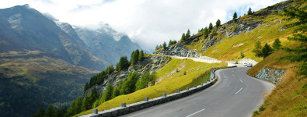16.06.2010
r.
Szczególny
rodzaj naturalnej sztuki.
Ogromne
naturalne piękno otwiera się przed nami
...

Podróż
w czasie poprzez High Alpine Road - trasą, którą
przemieszczali się
Celtowie i Rzymianie. Ten starożytny szlak ludzie przekroczyli prawie
dwa tysiące lat przed Chrystusem.
Malownicza alpejska droga Großglockner została
otwarta 3 sierpnia 1935 roku po pięciu latach budowy. Droga łączy dwa
kraje związkowe - Salzburg i Karyntię. Zamykana jest w godzinach
wieczornych, a czynna jest w okresie od maja do października.
Obecnie ponad
milion osób rocznie odwiedza Grossglockner High Alpine, co
czyni tą drogę najczęściej odwiedzaną atrakcją turystyczną po Zamku
Schönbrunn
w Austrii.
Zbudowana 75 lat temu, a jednak jej doświadczenie
i siła atrakcji nie słabną. Dzięki niej motocyklem, samochodem
lub autobusem można bezpośrednio dostać się do Parku Narodowego
Hohe Tauern, do stóp Grossglockner, na 3798 m najwyższy
szczyt w
Austrii.

Großglockner
(Grossglockner) to najwyższy szczyt Austrii, leżący w
Wysokich Taurach (Alpy), w grupie górskiej Glockner, o
wysokości 3798 m n.p.m. Drugi co do wybitności szczyt Alp (MDW: 2423
metry).
Wznosi się ponad lodowcem Pasterze, do którego
prowadzi droga samochodowa (w zimie zamknięta) – odgałęzienie
przebiegającej obok drogi glocknerskiej (niem. Bruck Heiligenblut).
Stopień trudności najłatwiejszej drogi na szczyt określany jest na PD+
(PD = fr. peu difficile – nieco trudno).
Wierzchołek
główny pierwszy raz zdobyty został 28 lipca 1800 roku.
Na charakterystyczny kształt szczytu (przypomina on piramidę) składają
się dwa wierzchołki - Großglockner oraz Kleinglockner.
Rozdziela je mała, wąska przełączka nazywana Glocknerscharte.
Pierwszego polskiego wejścia na szczyt dokonał Ludwik
Chałubiński z przewodnikami w 1884 lub 1885 roku.
Przepiękne alpejskie widoki dostępne są pod adresami:
*****
The Grossglockner High Alpine Road was opened 75 years ago. We
celebrate this anniversary by releasing a new 5 Euro silver coin.
The silver coin shows the Grossglockner High Alpine Road winding its
way through the mountainous landscape shortly before reaching the peak
of Grossglockner itself.
An elegant old timer from the days of the original opening in 1935 and
a sports car of our own time symbolise the 75 years of the famous
roadways existence.
The nine-sided shape of the coin represents the nine federal provinces
of Austria.
mintage: 50,000 pcs max., Fine: Ag 800/1000, weight: 8 gr. Date of
Issue: June, 16th, 2010
GROSSGLOCKNER
DRIVING ACROSS THE ALPS
Hannibal
crossed the Alps with elephants, Caesar marched over them, Napoleon
rode across, ladies and gentlemen were carried across in chairs, but
the Grossglockner High Alpine Road enables the crossing from the
province of Salzburg to Carinthia in the south by motorcar, bus,
motorbike or even bicycle, and that over Austria’s highest
mountain -
the Grossglockner.
On 3rd August, 1935, the high alpine road
over the Grossglockner mountain pass was officially opened to traffic.
From 1930 till 1935 during 26 months of construction, 870,000 cubic
meters of earth and rock were moved, 115,750 cubic meters of retaining
wall were built and 67 bridges were erected. A total of 3,200 men
laboured with the fairly simple tools of the day completing in record
time this marvel of mountain engineering.
The most famous of all
alpine roads leads one through the Hohe Tauern National Park to
Austria’s highest mountain, the Gross-glockner, and its
glacier, the
Pasterze. The engineer Franz Wal-lack planned a road that would fit in
harmoniously with its natural surroundings; a feature that has turned
out to be a great blessing for the national park.
In 1935 they
expected approximately 120,000 visitors per year, but already within
three years of its opening that number had doubled. On 48 kilometers of
panorama roadway with 36 hairpin bends climbing to a height of 2,504
meters, one travels through a fantastic world of giant mountains. Today
some 900,000 visi-tors come to Austria’s third most popular
tourist
attraction. Since 1935 some 50 million people have crossed from
Salzburg to Carinthia over the Grossglockner and in this year of its
75th anniversary, they expect to see the 60th million visitor to the
Grossglockner High Alpine Road.
To mark the 75th anniversary of
the opening of the high alpine road over the Grossglockner the Austrian
Mint in Vienna is issu-ing a silver commemorative 5 Euro coin on 16th
June, 2010.
The new coin shows the Grossglockner High Alpine
Road winding its way through the mountainous landscape shortly before
reaching the peak of the Grossglockner itself. An elegant
“old timer”
from the days of the original opening in 1935 and a sports car of our
own time symbolise the 75 years of the famous roadway’s
existence. The
other side displays the face value within a cir-cle of the nine shields
of the federal provinces of Austria.
This coin is produced in
special uncirculated quality for col-lectors to a maximum mintage of
50,000. They come packaged in a colourful and informative blister pack.
Another 250,000 pieces are issued at the face value of € 5 in
circulation quality through the banks. The nine-sided shape results
from the nine provincial coats-of-arms.
At the same time, on
16th June, the annual coin set in special uncirculated quality will be
issued. With a mintage of only 50,000, the new packaging shows the
baroque Belvedere Palace in Vienna as a tribute to the design on the
Austrian 20 Euro-cent circulation coin. A strictly limited version of
the set in proof quality will be issued in October.
źródło:
Austrian Mint / Wikipedia














